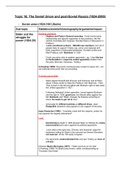Class notes
Summary of IB HL History of Europe - Topic 16
- Course
- Institution
Summary of IB HL History of Europe - Topic 16. Notes are made according to the syllabus for Paper 3. NOTE - ONLY STALIN'S RUSSIA IS COVERED IN THESE NOTES. POST-STALIN RUSSIA (ie. Khruschev, Brezhnev, Gorbachev and Post-Soviet Russia are NOT COVERED)
[Show more]



